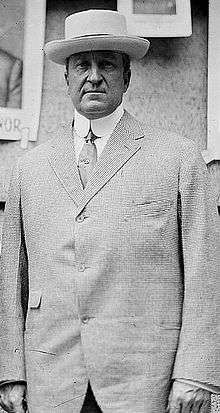John Alden Dix
| John Alden Dix | |
|---|---|
 | |
| 38th Governor of New York | |
|
In office January 1, 1911 – December 31, 1912 | |
| Lieutenant | Thomas F. Conway |
| Preceded by | Horace White |
| Succeeded by | William Sulzer |
| Personal details | |
| Born |
December 25, 1860 Glens Falls, New York |
| Died |
April 9, 1928 (aged 67) New York City, New York |
| Political party | Democratic |
| Religion | Episcopalian |
John Alden Dix (December 25, 1860 – April 9, 1928) was the 38th Governor of New York from January 1911 to December 1912.
Life
Born in Glens Falls, New York, Dix graduated from Glens Falls Academy and attended Cornell University from 1879 to 1882.[1] He was an initiated member of the Beta Charge of the Theta Delta Chi fraternity.
After college, Dix was employed in the Dix family businesses, including a quarry and a machine shop. He then began a career as the owner of several businesses in the lumber and paper making industry, the success of which made him wealthy.
He married Gertrude Alden Thomson, the daughter of Albany lumber merchant Lemon Thomson, who was Dix's business partner. Gertrude's sister, Nancy Sherman Thomson (1867–1927), was married to State Senator Curtis N. Douglas (1856–1919).[2]
Political career
Dixwas also became involved in politics, including serving as chairman of the Washington County Democratic Committee and the New York State Democratic Committee.
At the New York state election, 1908, Dix ran for Lieutenant Governor of New York on the Democratic ticket with Lewis S. Chanler, but was defeated.
At the New York state election, 1910, he ran for Governor of New York on the Democratic ticket and was elected. During his term, Dix established a New York State Factory Commission to investigate factory conditions, a reaction to the Triangle Shirtwaist Factory fire; as a result of the commission's work, 32 worker safety laws were enacted by the legislature and approved by Dix. After a fire destroyed a large portion of the state capitol building, Dix successfully advocated state legislation that improved fire safety regulations and building codes.
Other Dix accomplishments in office included creation of the state Conservation Commission, the law authorizing direct primary elections, and a law limiting work weeks to 54 hours. In 1912 he lost the Democratic nomination for Governor to William Sulzer.
Death and burial
After leaving office Dix retired to Santa Barbara, California. Mrs. Dix died there in 1923; the couple had no children.
Dix died in New York City on April 9, 1928, and was buried at Albany Rural Cemetery in Menands.
The other Governor Dix
John Alden Dix had the same first and last name as Union General and Governor of New York John Adams Dix, and was often referred to in the press as a nephew or a first cousin once removed of John Adams Dix. In fact, John Alden Dix had no known family relationship with John Adams Dix.[3]
References
| Wikimedia Commons has media related to John Alden Dix. |
- ↑ "The Ten Year Book of Cornell University Volume 2 1868–1888 pp.87".
- ↑ Douglas-Thomson genealogy at schenectadyhistory.org
- ↑ "The Dix Ancestry" transcription of a letter to the New York Times by Warren R. Dix, of September 24, 1908
| Party political offices | ||
|---|---|---|
| Preceded by Lewis S. Chanler 1906 |
Democratic Party nominee for Lieutenant Governor of New York 1908 |
Succeeded by Thomas F. Conway 1910 |
| Preceded by William. J. Conners |
Chairman of the New York State Democratic Committee 1910 |
Succeeded by Winfield A. Huppuch |
| Political offices | ||
| Preceded by Horace White |
Governor of New York 1911–1912 |
Succeeded by William Sulzer |
